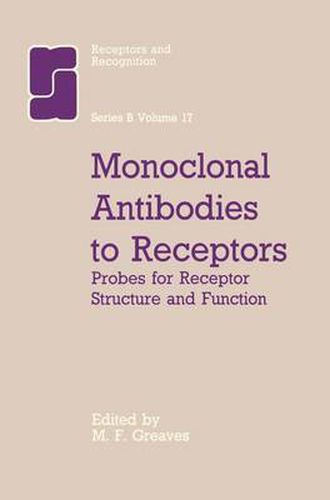Readings Newsletter
Become a Readings Member to make your shopping experience even easier.
Sign in or sign up for free!
You’re not far away from qualifying for FREE standard shipping within Australia
You’ve qualified for FREE standard shipping within Australia
The cart is loading…






This title is printed to order. This book may have been self-published. If so, we cannot guarantee the quality of the content. In the main most books will have gone through the editing process however some may not. We therefore suggest that you be aware of this before ordering this book. If in doubt check either the author or publisher’s details as we are unable to accept any returns unless they are faulty. Please contact us if you have any questions.
Receptor specific antibodies are excellent probes for a wide range of biological investigations on receptor structure and function. The hybridoma technology (Kohler and Milstein, 1975) has inevitably had a major impact on this field with most of the better known receptors now identified with monoclonal antibodies. This volume of the Receptors and Recognition series provides reviews of recent developments in this field and emphasizes in particular the new opportunities afforded by the judicious application of monoclonal reagents. It is assumed that most readers will be familiar with the now fairly routine methods of cell fusion, hybridoma cloning and selection for producing monoclonal antibodies and so few details of the basic technical procedures are described. Several good reviews on this topic are however available (see Galfre and Milstein, 1981; Goding, 1980; Yelton and Scharf, 1981; McMichael and Fabre, 1982). By no means all vertebrate receptor species are discussed here; omissions include antibodies to low density lipoprotein receptors (Beisiegel et al. , 1981; Kita et al. , 1981), prolactin and growth hormone receptors (Friesen etal. , 1982; Simpson et al. , 1983) and the hepatocyte asialoglycoprotein receptor (Schwartz et al. , 1981; Harford et al. , 1982). Nevertheless the coverage is comprehensive and critical and the individual chapters provided illustrate vividly the rapid progress being made.
$9.00 standard shipping within Australia
FREE standard shipping within Australia for orders over $100.00
Express & International shipping calculated at checkout
This title is printed to order. This book may have been self-published. If so, we cannot guarantee the quality of the content. In the main most books will have gone through the editing process however some may not. We therefore suggest that you be aware of this before ordering this book. If in doubt check either the author or publisher’s details as we are unable to accept any returns unless they are faulty. Please contact us if you have any questions.
Receptor specific antibodies are excellent probes for a wide range of biological investigations on receptor structure and function. The hybridoma technology (Kohler and Milstein, 1975) has inevitably had a major impact on this field with most of the better known receptors now identified with monoclonal antibodies. This volume of the Receptors and Recognition series provides reviews of recent developments in this field and emphasizes in particular the new opportunities afforded by the judicious application of monoclonal reagents. It is assumed that most readers will be familiar with the now fairly routine methods of cell fusion, hybridoma cloning and selection for producing monoclonal antibodies and so few details of the basic technical procedures are described. Several good reviews on this topic are however available (see Galfre and Milstein, 1981; Goding, 1980; Yelton and Scharf, 1981; McMichael and Fabre, 1982). By no means all vertebrate receptor species are discussed here; omissions include antibodies to low density lipoprotein receptors (Beisiegel et al. , 1981; Kita et al. , 1981), prolactin and growth hormone receptors (Friesen etal. , 1982; Simpson et al. , 1983) and the hepatocyte asialoglycoprotein receptor (Schwartz et al. , 1981; Harford et al. , 1982). Nevertheless the coverage is comprehensive and critical and the individual chapters provided illustrate vividly the rapid progress being made.